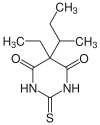Thiobutabarbital
 | |
| Clinical data | |
|---|---|
| ATC code | none |
| Identifiers | |
| |
| Synonyms | Thiobutabarbital, Inactin, Brevinarcon, 5-sec-Butyl-5-ethyl-2-thiobarbituric acid |
| CAS Number |
2095-57-0 |
| PubChem (CID) | 3032373 |
| ChemSpider |
2297366 |
| UNII |
2N0251U7JH |
| ECHA InfoCard | 100.016.600 |
| Chemical and physical data | |
| Formula | C10H16N2O2S |
| Molar mass | 228.312 g/mol |
| 3D model (Jmol) | Interactive image |
| |
| |
| | |
Thiobutabarbital (Inactin, Brevinarcon) is a short-acting barbiturate derivative invented in the 1950s. It has sedative, anticonvulsant and hypnotic effects, and is still used in veterinary medicine for induction in surgical anaesthesia [1]
References
- ↑ Rieg T, Richter K, Osswald H, Vallon V. Kidney function in mice: thiobutabarbital versus alpha-chloralose anesthesia. Naunyn Schmiedebergs Archives of Pharmacology. 2004 Oct;370(4):320-3.
| Alcohols | |
|---|---|
| Barbiturates |
|
| Benzodiazepines |
|
| Carbamates | |
| Flavonoids | |
| Imidazoles | |
| Kava constituents |
|
| Monoureides |
|
| Neuroactive steroids |
|
| Nonbenzodiazepines |
|
| Phenols | |
| Piperidinediones | |
| Pyrazolopyridines | |
| Quinazolinones | |
| Volatiles/gases |
|
| Others/unsorted |
|
See also: GABAergics | |
This article is issued from Wikipedia - version of the 4/2/2016. The text is available under the Creative Commons Attribution/Share Alike but additional terms may apply for the media files.